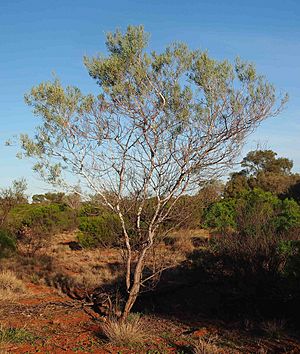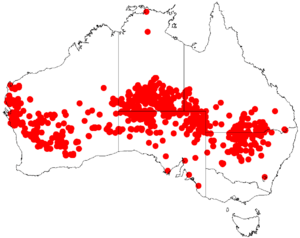Sandplain wattle facts for kids
Quick facts for kids Sandplain wattle |
|
|---|---|
 |
|
| Scientific classification | |
| Genus: |
Acacia
|
| Species: |
murrayana
|
 |
|
| Occurrence data from AVH | |
Acacia murrayana, also known as the sandplain wattle, is a special type of tree or large bush. It belongs to the Fabaceae family, which includes peas and beans. This plant is found only in the dry, desert-like areas of Australia. You can find it in every mainland state except Victoria. People also call it Murray's wattle, fire wattle, colony wattle, or powder bark wattle.
Contents
About the Sandplain Wattle
The sandplain wattle usually grows as a tall shrub or a small tree. It typically reaches a height of 2 to 5 meters (about 6 to 16 feet). Sometimes, it can grow even taller, up to 8 meters (about 26 feet). This plant can create new shoots from its roots, forming thick groups of plants called colonies.
Its branches are smooth and often look like they are covered in a fine white powder. This gives them a frosted look. Like most Acacia species, the sandplain wattle has special leaf-like parts called phyllodes instead of true leaves. These phyllodes are grey or pale green. They are usually 5 to 12 centimeters (about 2 to 5 inches) long and 2 to 7 millimeters (about 0.08 to 0.28 inches) wide. They are smooth and a bit leathery, shaped like a narrow oval. Each phyllode has a tiny, hard, curved tip. The main vein in the phyllode is not very clear, and other small veins are hard to see.
Flowers and Seed Pods
In Western Australia, the sandplain wattle blooms between August and November. In other places, it can flower as late as January. When conditions are good, it produces many bright yellow flowers and lots of seeds. The flowers grow in round clusters, each about 8 millimeters (0.3 inches) across. Each cluster has 25 to 50 golden or light golden flowers packed closely together.
After flowering, the plant produces flat, papery seed pods. These pods are 5 to 8 centimeters (about 2 to 3 inches) long and up to 1 centimeter (0.4 inches) wide.
How the Sandplain Wattle Got Its Name
The sandplain wattle was first officially described by a botanist named George Bentham in 1864. He included it in his big book called Flora Australiensis. For a while, it was called Racosperma murrayanum, but in 2006, it was moved back to the Acacia group.
The plant's specific name, murrayana, honors Dr. James Patrick Murray. He was a surgeon who collected a sample of this plant in 1862 during an expedition to Cooper Creek.
Where the Sandplain Wattle Lives
The sandplain wattle is found all over Australia's dry areas. You can often see it on sand ridges and in places where the ground has been disturbed.
In Western Australia, it grows in many different areas, including the Pilbara, Gascoyne, Mid West, northern Wheatbelt, and Goldfields-Esperance regions. It likes sandy soils and can be found on sandplains, sand dunes, and along creek-lines.
The plant's range stretches from places like Shark Bay and North West Cape in the west. It goes east through northern South Australia and the middle of the Northern Territory. It reaches the western edge of the Great Dividing Range in Queensland, near Mitchell, and in New South Wales, near Narrabri. Here, it often grows alongside other plants like mulga trees or spinifex grasses.

